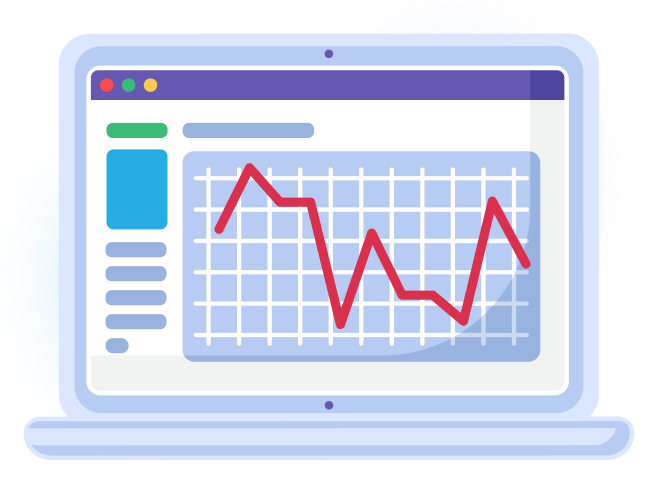


Algorithmic trading relies on multiple data sources such as historical price movements, trading volumes, and real-time market feeds
Backtesting involves running your algorithm through historical market data to evaluate its performance
High-quality data and advanced technological infrastructure are the backbones of successful algorithmic trading
What’s the secret to success in algorithmic trading? In this article, we explore how algorithmic trading works and how to effectively apply tools and strategies to the market.
Algorithmic trading involves using sophisticated computer algorithms to automate trading decisions and executions. This approach allows traders to process vast amounts of data and execute precise trades at lightning speed.
By eliminating the human emotional element, algorithmic trading ensures discipline in execution, leading to more consistent and profitable outcomes for day traders.
However, to maximize the benefits of algorithmic trading, careful consideration of strategy, technology, and risk management is crucial. Familiarity with artificial intelligence and machine learning is also essential, as these technologies are increasingly used to develop and refine predictive models.
Algorithmic trading at crypto prop trading firms involves several key components that work together to execute trades efficiently and profitably:
Data Analysis: Algorithmic trading relies on various data sources, including historical price movements, trading volumes, real-time market feeds, and other indicators to identify potential trading signals. By analyzing this data, algorithms can detect patterns and trends that inform trading decisions.
Backtesting: Before deploying a trading algorithm, it undergoes rigorous backtesting against historical data. This process helps refine the algorithm, allowing traders to estimate its potential profitability and identify any weaknesses. Backtesting ensures that the algorithm performs well under different market conditions before actual capital is involved.
Execution: Execution systems perform trades based on the criteria defined by the trader. These systems are designed to be fast and efficient, capable of executing trades in a fraction of a second. This speed minimizes slippage and market impact, ensuring that trades are carried out at the desired prices.
Risk Management: Effective risk management is built into trading algorithms by default. This includes ensuring that positions are appropriately sized and that exposures remain within predefined limits set by the trader. By managing risk in this way, traders can protect their capital and avoid significant losses.
Advanced trading algorithms at crypto prop trading firms are developed using a combination of statistical analysis, quantitative models, and artificial intelligence-based machine learning techniques. These sophisticated tools often identify potential entry and exit points that traditional financial indicators and chart analysis might miss. By leveraging these advanced techniques, traders can gain a competitive edge in the market.

Regardless of the trading tools employed by day traders, they must apply these tools to the market in an effective way. This means selecting a trading strategy that is likely to yield meaningful returns. The success of algorithmic trading at crypto prop trading firms heavily depends on choosing the right strategy tailored to different market conditions and objectives. Common strategies include:
Trend Following: This strategy involves researching and capitalizing on the momentum of existing market trends. Traders identify assets that are moving in a consistent direction and follow the trend until it shows signs of reversal.
Mean Reversion: This strategy is based on the idea that the price of an asset will revert to its historical average over time. Traders identify the average market value of an asset within a given timeframe and place trades betting on the price reverting to this mean.
Arbitrage: Arbitrage opportunities arise from price discrepancies between different markets or exchanges. Traders exploit these discrepancies by buying low in one market and selling high in another.
Momentum Trading: This strategy involves buying securities that are showing upward trends and selling those that are trending downward. The belief is that current trends will continue for some time, allowing traders to take advantage of momentum.
Before implementing any strategy in a live environment, backtesting is crucial. Backtesting involves running the trading algorithm through historical market data to assess its performance. This process helps ensure that the strategy is robust, adaptable, and not overfitted to past data, providing a realistic expectation of its effectiveness in live trading.
Selecting the right trading strategy is fundamental to the success of algorithmic trading at a crypto prop trading firm. Whether using trend following, mean reversion, arbitrage, or momentum trading, the key is to thoroughly test and validate the strategy to ensure it can deliver consistent and successful results in various market conditions.
Effective utilization of any trading strategy at crypto prop trading firms typically includes a close analysis of technical indicators. These indicators help highlight market opportunities based on mathematical models, allowing traders to make informed decisions. Commonly used technical indicators include:
Bollinger Bands plot price points above and below an asset’s moving average, providing a visual representation of its volatility. This indicator helps identify overbought or oversold conditions. When the price moves towards the upper band, it may indicate overbought conditions, while movement towards the lower band suggests oversold conditions.
This indicator is widely used in day trading strategies. A bullish signal is generated when a short-term moving average, such as the 5-day exponential moving average (EMA), crosses above a long-term moving average, like the 20-day EMA. Conversely, a bearish signal is indicated when the short-term moving average crosses below the long-term moving average. These crossovers can predict potential trends and help traders time their entry and exit points effectively.
The Relative Strength Index (RSI) is a momentum oscillator that measures the speed and change of price movements. It ranges from 0 to 100 and helps identify overbought or oversold conditions. An RSI above 70 typically indicates that an asset is overbought, suggesting a potential price correction. Conversely, an RSI below 30 indicates that an asset is oversold, suggesting a potential price increase. By using RSI, traders can gauge the strength of a price trend and make more informed trading decisions.
Utilizing advanced trading tools and platforms can significantly enhance the effectiveness of these technical indicators. High-quality trading platforms provide real-time data and sophisticated charting tools, enabling traders to perform detailed technical analysis and execute trades with precision.

By integrating these technical indicators into their trading strategies, traders at crypto prop trading firms can better navigate the volatile crypto market. These indicators not only provide valuable insights into market conditions but also help in managing risk and maximizing returns. The use of such tools is essential for developing robust trading strategies that can adapt to the dynamic nature of financial markets.
In conclusion, mastering the use of technical indicators is crucial for success in day trading. Crypto prop trading firms rely heavily on these indicators to identify trading opportunities, manage risk, and execute trades efficiently. By leveraging Bollinger Bands, moving average crossovers, and RSI indicators, traders can gain a competitive edge and enhance their overall trading performance.Technology and Data
High-quality data and advanced technological infrastructure are the backbones of successful algorithmic trading. Data accuracy is paramount, as erroneous data can lead to flawed trading decisions. Utilize reliable sources and ensure the data is clean and well-structured.
Real-time data is crucial for timely decision-making and execution. Delayed data can lead to missed opportunities or suboptimal trades. Consider incorporating alternative data sources, such as social media sentiment, news feeds, and economic indicators, to gain additional insights and a competitive edge.

Invest in robust technological infrastructure, including high-speed internet, powerful computing hardware, and sophisticated trading platforms. These tools can significantly enhance your trading capabilities and ensure seamless operation.
Effective risk management is vital to safeguard capital and ensure long-term success in crypto prop trading firms. Proper risk management techniques help traders navigate the volatile crypto market, minimizing potential losses and maximizing gains. Key aspects include:
Determining the appropriate size of each trade is crucial for managing risk exposure. Traders should calculate position sizes based on their overall trading capital and risk tolerance. By doing so, they can avoid significant losses that could deplete their trading capital. This involves using advanced trading tools to analyze market conditions and make informed decisions.
Setting predefined stop-loss and take-profit levels is essential for protecting against large drawdowns and securing gains. Stop-loss orders automatically close positions at a specified loss level, preventing further losses if the market moves against the trade. Take-profit orders lock in gains by closing positions at a predetermined level. This disciplined approach helps in maintaining a balanced risk-reward ratio and ensures consistent success in the crypto market.
Spreading risk by diversifying trading strategies and trading across different assets and markets is a key component of effective risk management. Diversification reduces the impact of a poor-performing strategy or adverse market conditions on the overall trading portfolio. Traders should explore various trading strategies such as trend following, mean reversion, arbitrage, and momentum trading to diversify their approach. This not only mitigates risk but also enhances the potential for steady returns.
Implementing advanced risk management strategies can further enhance the effectiveness of risk management in crypto prop trading. Techniques such as dynamic position sizing, where trade sizes are adjusted based on market volatility, and hedging strategies, which involve taking offsetting positions to reduce risk exposure, are valuable tools. Additionally, utilizing risk management strategies like value-at-risk (VaR) calculations can help quantify potential losses and set appropriate risk limits.
Risk management is not a one-time task but an ongoing process. Traders at crypto prop trading firms should regularly review and adjust their risk management strategies based on changing market conditions and performance feedback. This involves analyzing trading data, evaluating the effectiveness of current strategies, and making necessary adjustments to improve risk management practices continually.
By incorporating these risk management practices, traders at crypto prop trading firms can better protect their capital, enhance their overall trading performance, and achieve long-term success in the dynamic and often unpredictable world of crypto trading. Proper risk management ensures that traders can withstand market volatility and capitalize on opportunities while minimizing potential losses.
Optimizing algorithmic trading strategies at a crypto prop trading firm is an ongoing process that requires a multifaceted approach. The key to success lies in the careful selection of trading strategies, the utilization of high-quality data, robust trading platforms, and the implementation of effective risk management techniques.
Selecting the right trading strategies is fundamental. Traders must choose strategies that align with their goals and market conditions, whether it’s trend following, mean reversion, arbitrage, or momentum trading. Each strategy should be rigorously backtested using historical data to ensure it is robust and adaptable to various market scenarios.

High-quality data is another cornerstone of successful algorithmic trading. Accurate and timely data from reliable sources allows traders to make informed decisions and fine-tune their strategies. Utilizing advanced trading tools and platforms enhances data analysis, providing deeper insights and more precise trading signals.
Robust technology is crucial for executing trades efficiently. Prop crypto trading firms rely on sophisticated trading platforms that offer high-speed execution, advanced charting capabilities, and real-time data feeds. These platforms help minimize slippage and market impact, ensuring that trades are executed at optimal prices.
Effective risk management is vital to safeguarding trading capital and ensuring long-term success. Traders must employ techniques such as position sizing, setting stop-loss and take-profit levels, and diversifying their strategies across different assets and markets. Advanced risk management strategies, such as dynamic position sizing and hedging, further enhance the ability to navigate the volatile crypto market.
By implementing these tips, traders at crypto prop trading firms can enhance their performance, achieve more consistent results, and stay competitive in the fast-paced world of algorithmic trading. Continuous learning and adaptation are essential. As the financial markets evolve, so too must the strategies and technologies used to navigate them. Keep refining your trading strategies, leveraging new tools, and staying informed about market dynamics to succeed in the ever-changing landscape of algorithmic trading.
In summary, optimizing algorithmic trading strategies involves a blend of well-chosen trading strategies, high-quality data, advanced trading platforms, and comprehensive risk management. By focusing on these elements, traders can enhance their trading performance and maintain a competitive edge in the dynamic and fast-paced environment of crypto prop trading firms.